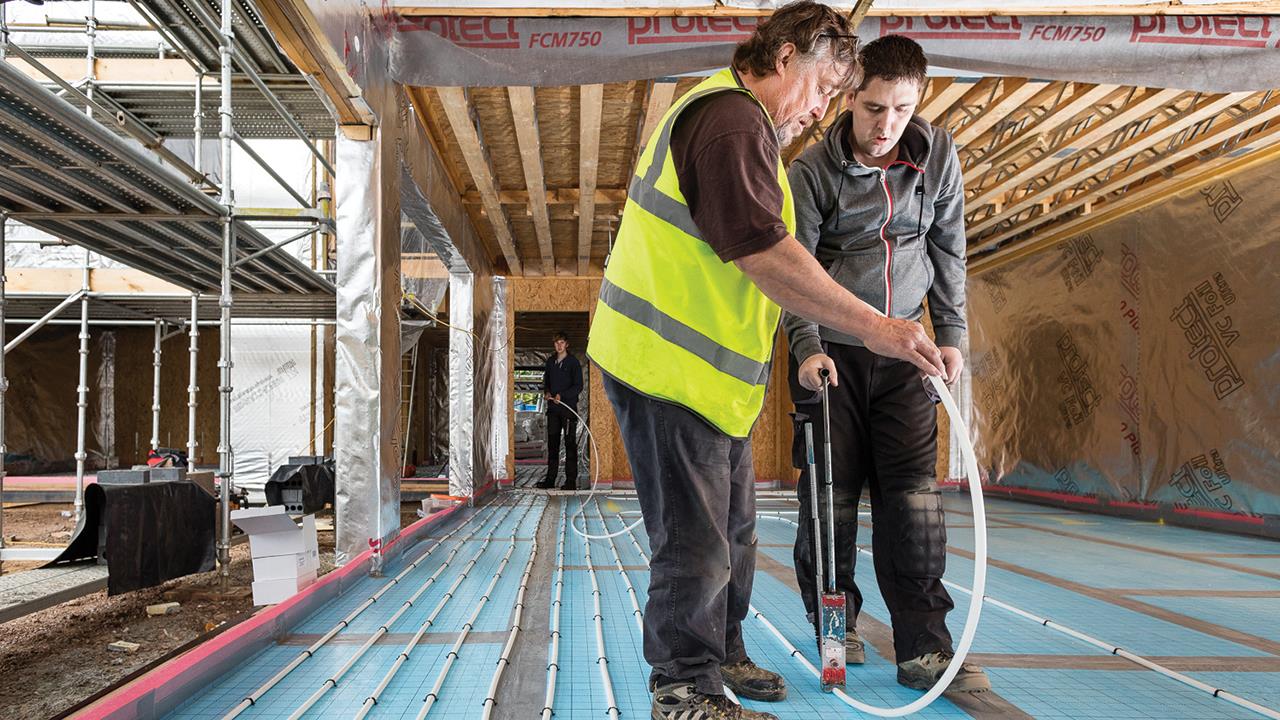

With underfloor heating offering efficiency, safety, freedom of design, and the ability to seamlessly pair with renewable technology, it’s clear to see why it’s a popular choice for any property. However, it doesn’t mean there is a one-size-fits-all solution for every project and getting the system specification right is key.
Starting from scratch – screeded floors
When working on a newly built home, or handling an installation for a full house renovation, incorporating underfloor heating pipework into the floor screed build-up offers many benefits.
Not only is this method a quick and cost effective way to install underfloor heating, it also ensures maximum output from the system as the warm pipes effectively heat up the whole solid floor slab to provide even and consistent heat.
It’s important to be aware that insulated screed will be required for most solid floor build-ups to meet the needs of Building Regulations, however this, along with any other insulation layers, can start to increase the floor build-up/level. So, always look for underfloor heating systems which can be fixed securely to the insulation board, without affecting the overall floor build-up.
With screeded systems, to avoid any damage to the underfloor heating system, it’s always advisable to schedule the screed process immediately after pipework installation.
Understanding the type of screed being used is also essential, and if a liquid screed is being used, the whole floor area must be sealed with a polythene layer to prevent screed from escaping.
Keeping floor build-up to a minimum
One common challenge with retrofit underfloor heating installations is floor build-up. In response, low profile systems have grown in popularity.
Low profile underfloor heating systems often incorporate a high density insulation panel to ensure the end result is as slim as possible. Some systems also include pre-grooved channels and a radius return in each panel, making them even easier to work with. These systems can be laid onto most upper and ground floor surfaces to provide an even heat output with minimal floor build-up.
As with any installation, it’s crucial to ensure the sub-floor – whether it be concrete or timber-based – is perfectly flat and level before installing the underfloor heating system. Sub-floors that are incorrectly or badly prepared may cause problems down the line, with potential damage to the floor finishes.
Overlaying an existing sub-base
Unlike a screeded system, a floating underfloor heating design is ideal for laying directly onto a sub-base of concrete or chipboard, or in between timber battens, as these scenarios will likely require a tailored system.
Underfloor heating systems which are suitable for floating floors usually incorporate insulation as part of the panels, which may also be pre-grooved to take the underfloor heating pipework. The system is then overlaid with either a foil or aluminium diffusion plate to assist the distribution of heat. The final addition is a fully floating floor deck, onto which the floor finish is applied. In the case of wooden floors, the deck can often be laid directly on to the insulation to minimise height build-up and maximise heating output.
If a project requires a floating system, to make the installation as quick and easy as possible, work with a supplier which can easily cater for any bespoke requirements. In some cases, this may mean that each polystyrene insulation panel is manufactured specifically for the project to mirror the underfloor heating design drawings.
Bespoke systems
There are a number of reasons why a bespoke design could be needed, especially if the project has specialist requirements.
For example, a joisted system may be required but the spacing of the joist is very irregular, there may be a need for a stringent acoustic layer to be installed under the system, or, for solid wall properties, a highly specialised ‘breathable’ system may be required.
Thanks to the flexibility of underfloor heating, with the right design and installation, most properties can benefit from an efficient system, whatever the conditions on-site.
The key is to work with a supplier which can assist with the design, including pipework layouts and heat output calculations – and, if necessary, create a bespoke system to suit any specific project specifications. This may include supplying completely bespoke installation instructions for the bespoke system to ensure the job runs smoothy and maximum output is achieved.
If you'd like to keep up-to-date with the latest developments in the heating and plumbing industry, why not subscribe to our weekly newsletters? Just click the button below and you can ensure all the latest industry news and new product information lands in your inbox every week.